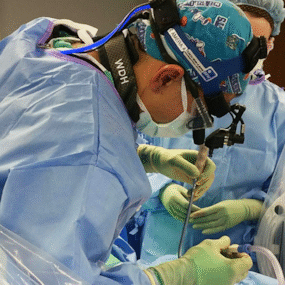Minimally Invasive Techniques for Lumbar Stenosis
What is lumbar stenosis?
 Lumbar stenosis is the gradual narrowing of the space where nerves pass through the spine. This narrowing can compress and irritate the nerves branching out from the spinal cord, causing pain or numbness in the lower body.
Lumbar stenosis is the gradual narrowing of the space where nerves pass through the spine. This narrowing can compress and irritate the nerves branching out from the spinal cord, causing pain or numbness in the lower body.
Symptoms:
- Decreased endurance during physical exercise and activities
- Numbness/tingling, weakness or cramping in legs, calves or buttocks
- Lower back pain
- Hip pain
- Buttock pain
- Leg pain
- Symptoms improve when sitting, leaning forward or laying on the back
Causes
Lumbar stenosis is caused by changes in the shape and size of the spinal canal as people age. Lumbar stenosis is most common in adults over the age of 50 and is typically caused by arthritis of the spine.
- Bone overgrowth: Joint disease called osteoarthritis can prompt the growth of bone spurs, which push on the spinal cord.
- Thickened ligaments: Connective tissue can become thick and stiff over time; these thicker ligaments can bulge into the spinal cord.
Non-surgical treatment
Mild to moderate symptoms can typically be managed with pain medications, exercise and physical therapy. Also, steroid injections may be helpful; however, they seem to only offer temporary improvement.
Surgical treatment
If your symptoms worsen or limit your activities, there are multiple surgery options:
Decompression laminectomy surgery: This is the most common surgical treatment for lumbar stenosis; it involves removing the bone or ligaments that are pressing on the spinal cord and/or nerves. A surgical procedure removes a portion of the vertebral bone, called the lamina, to widen the spinal canal; this creates more space for the formerly compressed spinal nerves.
This can be accomplished by many different approaches – standard laminectomy, microsurgery laminectomy, decompression with possibly a lateral fusion (with no screws and rods), interlaminar lumbar interbody fusion (with instrumentation), posterior decompression with fusion and instrumentation; possibly a lateral type of fusion (XLIF®). These different approaches correspond to the patient’s examination and other abnormalities seen on MRI.
These micro-neurosurgical techniques are less disruptive to the body’s tissues, minimizing patient discomfort and recovery time.

